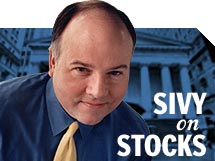Two stock leaders: Solid growth, great yieldsLow prices, ample dividends and smart business plans give B of A and DuPont the chance for further gains.New York (Money Magazine) -- Stocks had a big run in the second half of 2006, with the Dow shooting up 16 percent. Plenty of big growth companies shared in the gains, including 46 of the Sivy 70 that are now trading near their 2006 highs. Considering that real estate prices are sinking and some economists are warning of a slump, you may be wondering if this is the time to trim your portfolio and take profits on your big winners or whether a few market leaders are still worth buying.  It's always worth checking to see if top-performing stocks have reached levels where you should sell. But as a group, blue chips aren't overvalued. Their price/earnings ratios are still slightly below their historical average, and some are trading at discounts as big as 20 percent. So you can still find bargains that offer good chances for further gains in 2007, as well as protection against losses if the economy hits a bad patch. Here's what I look for: A price near the 2006 high. You might think that stocks near their highs are the most vulnerable to setbacks. But market leaders typically have improving outlooks, while stocks that couldn't keep up are still struggling with problems. That doesn't mean depressed stocks are always bad buys. Last month I recommended Home Depot (Charts), which has been hurt by the housing slump, because it looks like a long-term bargain. But a stock that has been advancing and still looks fairly priced is most likely to keep leading the market. A low price/earnings ratio. Shares with P/Es below the typical blue chip's 16.8 are attractive because they can deliver gains if their multiples simply rise to an average level. All it would take is for their strengths to be more widely recognized. A dividend yield of 3 percent or more. Stocks that pay considerably more than the 1.7 percent of the S&P 500 tend to be less risky because high payouts would help support their share prices in a weak market. Screening the Sivy 70 by these measures gets you down to half a dozen stocks. But there's one more quality to look for: You want a company that is reshaping its business to speed up earnings growth and attract new buyers. Two that really stand out are Bank of America and DuPont. B of A could be No. 1 With a fat 4.2 percent yield, Bank of America (Charts) is a favorite for income. But the financial services company has also been expanding so fast that it may soon be No. 1, surpassing Citigroup (Charts). Over the past 15 years, B of A has acquired a string of domestic banks. Now CEO Ken Lewis is beefing up other areas. After buying MBNA, B of A is the top issuer of credit cards. The announced purchase of U.S. Trust from Charles Schwab will also make B of A the largest private bank. Recently the bank was reportedly talking about a merger with Barclays, a leader in the U.K. Expansion offers the chance to enhance profit margins by cutting costs. Ultimately, though, a bank's profitability depends on interest rates. With short- and long-term rates nearly equal, lending isn't a great business nowadays. But once the Federal Reserve starts lowering short-term rates, margins should snap back, giving earnings a quick boost that would hand a huge bonus to investors who buy Bank of America today. DuPont goes high-tech Perpetually tied with Dow for the title of biggest U.S. chemical company, DuPont (Charts) has the reputation of being stodgy and overly dependent on low-profit commodities like bulk chemicals. But that business hides a high-tech DuPont that's going global. CEO Chad Holliday recently noted that a third of the company's 2006 revenue would come from new products and added that the percentage has risen for six years in a row. DuPont's past successes include Teflon for nonstick pans and Kevlar for bullet-proof vests. But today's hot products are even more sophisticated. Among them: solar cells and filtration membranes. DuPont has also cut back its old-line agricultural business, including herbicides and insecticides, and is pouring the money it saved into genetically engineered seeds and other biotech products. Some of these projects have great opportunities in the U.S., particularly in energy conservation. But the greatest potential is overseas. More than a third of DuPont's revenue comes from outside the world's leading economies. And emerging market revenue has more than doubled over the past five years. It's hard to resist growth like that when it comes wrapped in a 3 percent yield. ____________________ |
|
